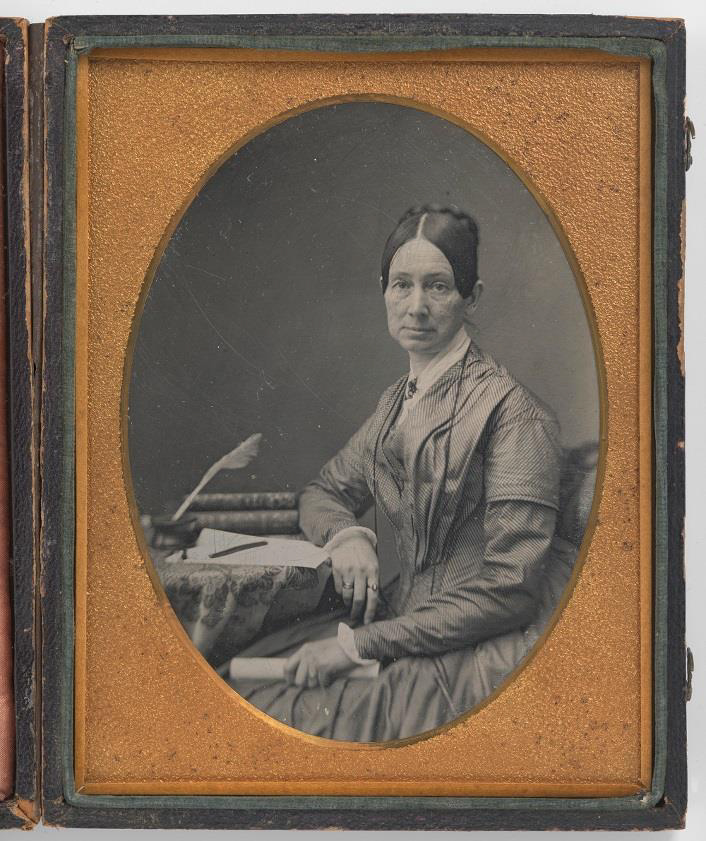Last Updated on 06/24/2019 by Chris Gampat
Daguerreotype remains a fascinating photographic process to this day, and recent research gives us more reasons to remain impressed.
It’s been nearly two centuries since Louis Daguerre introduced his daguerreotypes, yet the allure of the early photographic process remains as strong as ever. In fact, it intrigued an interdisciplinary team of scientists to conduct research on the unique characteristics of the images produced on silver plates, particularly how they can look slightly different depending on the viewing angle. They discovered that this curious optical effect is created by the presence of metallic nanoparticles — 19th-century nanotechnology, as they decided to call it.
Cover photo: Daguerreotype characteristics. (A) Daguerreotype in the study collection of The Metropolitan Museum of Art (artist unknown, ca. 1850s). The perimeter has a blue gradient created by an oval mask applied during sensitizing and mercury development. (B) Scanning electron microscope (SEM) images, outlined in colors corresponding to colored circles in A, show varying nanoparticle densities, from Top to Bottom, in highlight, midtone, shadow, and blue-tinted regions of the image. (Scale bars, 2 μm.) (C, i–viii) Schematic outlining the steps of the daguerreotype process. (D) Particle size counts, averages (red dashed line), and SD (black bar) for daguerreotype samples (Insets). Hg1 and Hg4 refer to minutes of mercury exposure, and UG and G refer to ungilded and gilded plates, respectively. Blue lines represent blue mask regions, while gray lines correspond to the regions of highest light exposure (i.e., highest particle density) of the exposure step wheels, marked by gray circles in Insets. (From the paper by Andrea E. Schlather, Paul Gieri, Mike Robinson, Silvia A. Centeno, and Alejandro Manjavacas.)
In their report, Ars Technica shared the new paper by Rice University postdoc Alejandro Majavacas and his co-author Andrea Schlather of the scientific research department at the Metropolitan Museum of New York. They also described how the two ended up combining their expertise to apply nanoplasmonics — a field that explores how nanoparticles interact with light — to do research on daguerreotype images. The findings, they thought, could be useful for preserving The Met’s valuable collection of daguerreotypes.
For those who aren’t familiar with the daguerreotype process yet, here’s a brief description. A silver-plated copper substrate was polished into a mirror-like surface, then treated with iodine vapor to make it light sensitive. The treated plate was placed inside the camera and exposed to capture a latent image. Mercury vapor was used to reveal the image, and the plate would be rinsed with a hot saturated solution of common salt and dried afterward to fix the image. Gilding or gold toning was later added to the process by Hippolyte Fizeau in 1840 to give the gray image a slightly warmer tone. It was done by pouring gold chloride solution over the image, briefly heating it over a flame, then rinsing and drying it. This also physically reinforced the powdery silver particles of the image. Finally, it’s put under glass to protect the image.
For their study, Manjavacas and Schlather wanted to understand what was going on at the nanoscale level with the daguerreotype process. However, they couldn’t use the fragile and highly valuable 19th-century daguerreotypes for the experiments. As Manjavacas said, they needed something that they could “literally break pieces apart” from.
This was where Michael Robinson, one of the world’s best daguerreotype artists, came into the picture. There couldn’t have been a better person to join the team, as he actually wrote about the techniques and aesthetics of this traditional process for his PhD thesis. Since he was able to create daguerreotypes as they would have done it in the 19th century, the team was able to make experiments with computer simulations of electromagnetic effects.

National Portrait Gallery, Smithsonian Institution.
Their findings reveal some really cool facts about daguerreotypes. The images we see are created by metallic nanoparticles that scatter light off the reflective silver nitrate. This explains how the gold atoms in the salts and the gilding method work their magic on these one-of-a-kind images.
“Daguerreotypes, unlike other types of photographs, rely on light scattering by metallic nanoparticles to create an image that projects off a reflective silver substrate. The balance between the light scattered by the nanostructure and the spectacular reflection on the substrate creates the bright and dark tones, respectively, with the behavior of the midtones depending on the density of the nanostructures.”
If you want to know more about all the awesome science involved in daguerreotypes, make sure to check the full Ars Technica feature and the “Nineteenth-century nanotechnology” paper for Proceedings of the National Academy of Sciences by Manjavacas, Schlather, Robinson, and the rest of their team.
Thanks Ellis, for the tip!


